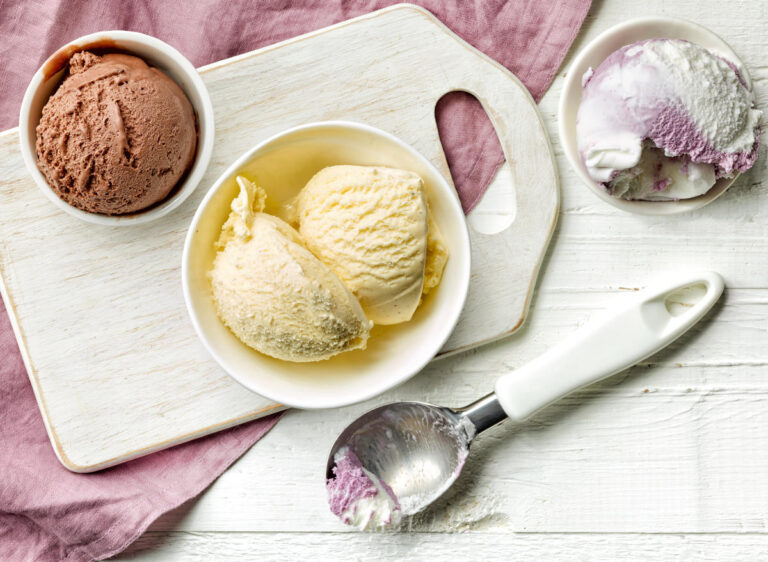Hot chocolate may be the perfect winter dessert, but when the temperatures rise, desserts that cool you down are in order. That’s why ice cream reigns supreme during the summer season: This sweet and creamy concoction is perfect for enjoying during the sweltering heat, even if you risk brain freeze.
Like many desserts, ice cream gets a bad rap. It’s meant to be enjoyed only occasionally due to its high sugar and fat content. However, experts say ice cream isn’t exactly the villain of your summer…and may even have some surprising health benefits. Here’s what you need to know.
Does ice cream have nutritional benefits?
Registered dietitian Shelley Balls tells Yahoo Life that a two-thirds cup serving of dairy ice cream is a good source of calcium, or about 12 percent of the recommended daily amount.
While the exact amount of calcium varies from brand to brand, Balls says, “Calcium is generally an under-consumed nutrient in the American diet, so it’s great news that when we decide to indulge in a sweet treat, it may also provide some nutritional benefits.”
Another win for ice cream? Balls says ice cream can also provide about six grams of protein per serving, depending on the brand — the same amount of protein found in a single hard-boiled egg or a 1-ounce serving of almonds.
Registered dietitian Stephanie Van’t Zelfden tells Yahoo Life that she often recommends ice cream as a dessert for clients with diabetes or blood sugar issues because it contains fat and protein. By combining fat and protein with sugar, “you reduce the blood sugar spikes that you might see when you eat low-fat desserts like sorbet,” she explains.
How to make ice cream more nutritious?
For the record: You don’t need to “maximize the nutritional value of every food,” Zelfden says. “Ice cream is one of those foods that we don’t eat because of its nutritional value, and that’s okay,” she says. “The ‘healthiest’ ice cream is the one that fills your heart and stomach.”
Instead of settling for the healthiest ice cream that you may not enjoy, focus on eating the ice cream you love most, in moderation. This might mean only eating your favorite sundae on Fridays, instead of settling for a lower-quality “healthy” version more often throughout the week.
That said, there are ways to make ice cream a little more nutritious, if that’s something you’re craving. For example: You can improve the nutritional profile of ice cream by making it at home, such as with a traditional ice cream maker or a tool like the Ninja Creami.
(Many people now make “protein ice cream” in their Ninja Creami, using frozen ingredients that are typically found in a protein shake. It’s never going to taste exactly like a McFlurry, but it can be a tastier substitute for a shake.)
More traditional homemade ice creams (which are made more for fun than to hit your macros) still allow you to control the amount of sugar, type of milk, and other basic ingredients. Balls notes that you can “add fruit, nuts, peanut butter, etc., to make [your ice cream] unique and richer in nutrients.”
What can I add to my ice cream to make it more nutritious?
Registered dietitian Kylie Bensley, founder of surgical nutrition program Sulinu, tells Yahoo Life that ice cream is naturally filling because of its fat content. However, you can play around with the ingredients by adding toppings to boost its fiber, protein, and healthy fat content. This could mean adding almonds to your sundae, chopping up strawberries or bananas, or even making a milkshake with a handful of frozen berries.
If you like the taste, you can also get creative and add things like chia seeds, hemp seeds, or even oats to your ice cream, which can add a unique flavor and an extra nutritional boost of fiber and protein.
I’ve heard bad things about soft serve ice cream machines…but I love them. Help!
You may have heard of soft serve ice cream machines that have mold or have never been cleaned. It is true that soft serve ice cream machines can grow dangerous bacteria or mold if they are not cleaned properly every 10 to 24 hours.
Food scientist Bryan Quoc Le told Yahoo Life that the majority of soft-serve ice cream machines have “acceptable microbiological safety profiles,” meaning they don’t have concerning levels of bacteria. In a study of soft-serve ice cream machines, researchers found that 74% of point-of-sale machines delivered soft-serve ice cream without issues, Le said.
However, according to Le, the remaining 26% were of poor quality and produced soft serve ice creams containing high levels of bacteria. The microorganisms present in these soft serve ice cream machines can “cause stomach upset or diarrhea, but they are unlikely to pose a serious health problem with long-term complications,” Le says.
If you don’t want to risk getting sick, there are ways to achieve that soft-serve ice cream consistency at home, such as with no-churn ice cream recipes. You can also use a homemade ice cream maker to make ice cream and other frozen treats with a soft-serve consistency.


